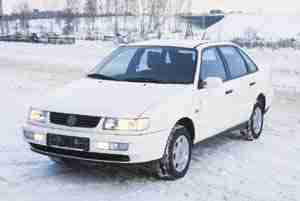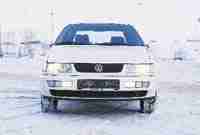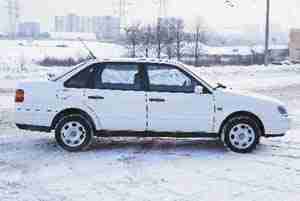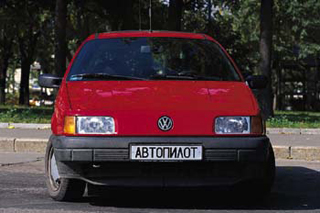Test drive Volkswagen Passat B5 1996 - 2000 sedan
8 years later
 In the production range of the German concern Passat appeared after Golf, as part of the general program for expanding the model range. The very first Passat was small, a little longer than Golf. In the basic configuration, the car was a frank low -commandment, with a 1.3 liter engine. But there were more powerful motors with a volume of 1.6 liters, one of which had a central injection and could aggregate with an automatic gearbox.
In the production range of the German concern Passat appeared after Golf, as part of the general program for expanding the model range. The very first Passat was small, a little longer than Golf. In the basic configuration, the car was a frank low -commandment, with a 1.3 liter engine. But there were more powerful motors with a volume of 1.6 liters, one of which had a central injection and could aggregate with an automatic gearbox. Passat had three bodies: a five -door hatchback, a station wagon and a compartment. The coupe body is very advanced and extremely rare for Europe in the early 70s got into many textbooks of the time as an example of aerodynamics and design.
The car turned out to be very hardy. One of us had such a 1973 Passat release with 1.3 liters of a motor. This machine had only a hatch in a roof with a mechanical drive from additional equipment. By the way, for more than 20 years of operation of the car, neither the seal nor the Luke’s drive was never failed. The carburetor engine started in any frost, the stove was excellently warm and never flowed. For the entire service life, only a gas pump was replaced, which failed somewhere after 300 thousand km of run. I had to part with the car because of the refusal of mechanics, which often happens to the elderly cars, Longerone just cracked from corrosion.
Having removed the first Passat from production in Europe, but nevertheless leaving it in the Brazilian branch, in 1980, Volkswagen put a higher class and noticeably larger on the Passat 2 conveyor. He has 1.6 liters of engine base. There were two types of body: a five -door hatchback and a station wagon. When a year remained before replacing the car on the conveyor, the concern decided to check the Passat market reaction with a sedan body. This was the first Volkswagen Passat in more than 15 years with such a body. He even received his own name Volkswagen Santana.
The marketing experiment led to the fact that the third -generation Passat, which debuted in 1988, had a sedan basic body, and a universal appeared a little later. And no hatchbacks. At the third round of evolution, Passat not only grew again, but also finally established himself in the gamut, as the largest and most solid Volkswagen.
The 1988 Passat did not have a radiator grille in the spirit of the American fashion of that time (this is the original solution used by Jack Telnak, the chief designer of Ford of Europe, on the Sierra model, struck the audience). Restyling 1993, among other things, returned the lattice and made the appearance of Passat more traditional.
Third -generation Passat, the car is well known and popular in Russia. Available with two types of body: sedan and station wagon. Moreover, a rather rare case in the universal automotive is much more beautiful than the sedan.
Equipment levels in the Passat gamut three CL, GL and GT. In addition, there is a full -wheel drive version of Syncro. In the extensive range of engines, the most interesting VR6. Volkswagen still has the concept of basic equipment, but everyone can choose additional equipment from a vast list of several dozen pages.
 The instrumental set is not rich in a jack, a cylinder key, a towing hook, a screwdriver and the only key 10x13, with which it will not be possible to repair the car. More or less serious breakdown of Volkswagen Passat is treated only in the service.
The instrumental set is not rich in a jack, a cylinder key, a towing hook, a screwdriver and the only key 10x13, with which it will not be possible to repair the car. More or less serious breakdown of Volkswagen Passat is treated only in the service. In Europe, there are more than 9,000 maintenance and repair stations Volkswagen. In Moscow, Passat serve about 12 service enterprises. The manufacturer gives an annual warranty on the car, regardless of the mileage, three -year -old varnishes and six -year -old from the through corrosion of the body. The duration of the warranty on the proprietary spare parts and all the accessories purchased from Volkswagen 1 year.
Some recommendations of the factory operating instructions and the advice of specialists with the experience of service and repair Passat may seem trivial, and sometimes incomprehensible or even strange. But one or another meaning in them is usually.
For example, it is recommended not to warm the engine in a fixed car, but immediately after starting to start moving. True, avoiding increased engine load. For some, this advice may seem wild, but it has long been established that the engine wear and fuel consumption during heating are especially large, and the engine is heating up for a long time at idle. It is more profitable to start the movement of the motor warm faster, and its wear will be less.
Another factory recommendation to check the oil level in the engine at each refueling of the car with fuel. It is explained in detail that the oil consumption depends on the load on the engine and driving manners, and can reach 1 l/100 km. It is emphasized that oil consumption is stabilized only after a run of 5000 km (this is true both in relation to fuel consumption and the engine power). In the very most detailed instructions for the maintenance of the car, I had to read that it is allowed to flow the engine oil through the engine oil seals in a volume of 150 g per day. Of course, the oil does not whip from the new Passat, but, as you can see, the manufacturer fenced himself from possible claims of the client.
The oil change in the diesel engine is recommended to be carried out twice as often as in gasoline. Be prepared for the fact that at the station they will advise you to pre -rinse the engine. Mechanics can invite you to be present when replacing, because freshly laid oil with good detergents will instantly turn black and you will have doubts, and whether it has changed it at all.
German order: it is allowed to use oil manufacturers, but provided that they are suitable for Volkswagen cars. The packaging should have an appropriate marking: VW 500 00, VW 505 00 or VW 501 00. It is forbidden to add any additives, malfunctions caused by the use of such mixtures are not subject to elimination.
Oil (ATF) in an automatic checkpoint must be changed every 60 thousand km or once every two years. Passat cannot be poured into the Passat cooling system, only branded antifreeze is allowed.
For fuel. Volkswagen has long been refused and produces cars only with fuel injection, but there are features here. For example, gasoline in the tank of a car equipped with a catalytic neutralizer is not recommended to be spent to the end.
Due to the possible uneven supply of fuel to the engine, interruptions in its operation are likely. This will lead to the ingestion of unsuccessful fuel into a catalytic neutralizer, which threatens it with failure. Another reason why you should not produce a leisure tank, after refueling it is difficult to start a car, along the empty gas pipeline, the fuel will reach the nozzles for a long time.
With diesel engines, there are also problems in winter diesel fuel can turn out to be summer, and winter in summer. The first option is worse than it will freeze in fuel highways. The manufacturer allows in this case to add up to 20% of gasoline to the tank in order to somehow dilute the fuel.
For many, a run of 15 thousand km is a year of operation of the car. Every 15 thousand km, the so -called. Oil service, and every 30 thousand (but at least once a year) inspection maintenance. Service includes such a volume of work so that you do not bother you in the car for another year, except gasoline refueling. Well, sometimes still add liquid to the windshield washer tank and check the tire pressure.
 Some domestic owners serve their cars themselves in order to save money. If it is a Passat car, a craftsman can be in wait for the expectation. For example, the timing belt must be changed after 90 thousand km, its cliff threatens to replace the valves, or even the entire head of the block, this is known. But not everyone knows that Passat needs to change and a tension roller with an aluminum when replacing the belt, rotates on a steel axis without a bearing and works about the same as the belt.
Some domestic owners serve their cars themselves in order to save money. If it is a Passat car, a craftsman can be in wait for the expectation. For example, the timing belt must be changed after 90 thousand km, its cliff threatens to replace the valves, or even the entire head of the block, this is known. But not everyone knows that Passat needs to change and a tension roller with an aluminum when replacing the belt, rotates on a steel axis without a bearing and works about the same as the belt. The front brake pads serve 25-30 thousand km, the rear 80-90 thousand. Every two years it is necessary to change the brake liquid, otherwise moisture accumulating in it can lead to corrosion of brake cylinders.
The clutch service life, as usual, is highly dependent on the driving manner. The competent owners have enough of it for 160-200 thousand km. With wear of even one part, it is recommended to change the clutch in the collection (a driven disk leading disk, a squeezing bearing and a guide sleeve, the cost of the DM650 kit), since the replacement of others will soon be required, and the cost of the work is quite large DM450.
It is forbidden to pour general use fluids into the power steering system, even if it is written on the package that this Power Steering Fluid is suitable for all types of machines. For Passat, only a special G00200 green liquid is suitable. If you do not follow this recommendation, you will have to fork out the cost of DM1000 to the pump. And since it changes as a single knot with a rail, add its cost DM700-800. Plus work on replacing DM400. A liter of G00200 at the service station costs only DM25-30.
The generator bearings serve 7-8 years if the belt is stretched correctly. The starter is recommended to disassemble and clean once every 3-4 years. The wheels bearings in principle do not create problems. The rear (two conical ones) fail more often than the front ones and require periodic adjustment. The front (two -row ball) is more powerful and go much longer. There is a DM130 bearing, and the operation to replace it DM710.
In general, the operation of Passat is not too burdensome. For many years of the presence of these machines on our roads, they showed that with a reasonable attitude to the technique and compliance with factory recommendations, any purely Russian breakdowns do not arise. The car serves both Western Europe and in Russia equally and well.
We thank Sokolov’s seeds for help in working on the material.
Sergey Aslanyan, Alexander Pikulenko
Source: Motor magazine [No. 03/97]
VOLKSWAGEN PASSAT B5 1996 - 2000
Volkswagen Passat B5 1996 test drives - 2000
Krash Test Volkswagen Passat B5 1996 - 2000
Krassh Test: Detailed Information19%
Driver and passengers
Malfunctions Volkswagen Passat B5 1996 - 2000
Volkswagen Passat malfunctions: Detailed information| Passat B5 1996 - 2000 | |
|---|---|
| Engine |  |
| Transmission |  |
| Control system and suspension |  |
| Brake system |  |
| Air heating and air conditioning |  |
| Launch and charging system |  |
| Electric components and so on |  |
| Corrosion body stability |













